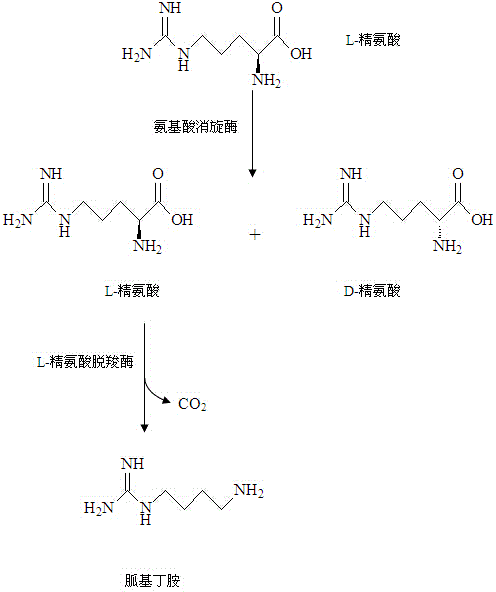Method for coproducing D-arginine and gamatine through biotransformation
A technology for agmatine and arginine, which is applied in the field of biotransformation and co-production of D-arginine and agmatine, can solve the problems of low yield, heavy pollution, and many steps in the chemical route, and achieve high Conversion rate, simple separation and purification, and high catalytic enzyme activity
- Summary
- Abstract
- Description
- Claims
- Application Information
AI Technical Summary
Problems solved by technology
Method used
Image
Examples
Embodiment 1
[0060] A method for the co-production of D-arginine and agmatine by a biological method, the production method comprising the following steps:
[0061] Step 1, preparation of genetically engineered bacteria expressing arginine racemase
[0062] (1) Liquid culture Pseudomonas putida KT2440 strain, extract its genomic DNA, and set aside;
[0063] (2) Primers were designed according to the DNA fragment gene sequence of Pseudomonas putida KT2440 with the accession number AE015451.1 recorded in the global public sequence database Genebank, and the designed primer sequences were as follows:
[0064] F-argR-NdeI: GGGCGGC CATATG CCCTTTCGCCGTACCCTTCTGG (its base sequence is shown in SEQ ID NO: 1);
[0065] R-argR-BamHI:CAT GGATCC TCAGTCGACGAGTATCTTCGG (its base sequence is shown in SEQ ID NO: 2);
[0066] According to the designed primers, high-fidelity KOD polymerase was used for PCR amplification. The PCR reaction program was: 94°C pre-denaturation, 5min; 94°C denaturation, 30s,...
Embodiment 2
[0085] A method for the co-production of D-arginine and agmatine by a biological method, the production method comprising the following steps:
[0086] Step 1, preparation of genetically engineered bacteria expressing arginine racemase
[0087] (1) Liquid culture Pseudomonas putida KT2440 strain, extract its genomic DNA, and set aside;
[0088] (2) Primers were designed according to the DNA fragment gene sequence of Pseudomonas putida KT2440 with the accession number AE015451.1 recorded in the global public sequence database Genebank, and the designed primer sequences were as follows:
[0089] F-argR-NdeI: GGGCGGC CATATG CCCTTTCGCCGTACCCTTCTGG (its base sequence is shown in SEQ ID NO: 1);
[0090] R-argR-BamHI:CAT GGATCC TCAGTCGACGAGTATCTTCGG (its base sequence is shown in SEQ ID NO: 2);
[0091] According to the designed primers, high-fidelity KOD polymerase was used for PCR amplification. The PCR reaction program was: 94°C pre-denaturation, 5min; 94°C denaturation, 30s,...
Embodiment 3
[0110] A method for the co-production of D-arginine and agmatine by a biological method, the production method comprising the following steps:
[0111] Step 1, preparation of genetically engineered bacteria expressing arginine racemase
[0112] (1) Liquid culture Pseudomonas putida KT2440 strain, extract its genomic DNA, and set aside;
[0113] (2) Primers were designed according to the DNA fragment gene sequence of Pseudomonas putida KT2440 with the accession number AE015451.1 recorded in the global public sequence database Genebank, and the designed primer sequences were as follows:
[0114] F-argR-NdeI: GGGCGGC CATATG CCCTTTCGCCGTACCCTTCTGG (its base sequence is shown in SEQ ID NO: 1);
[0115] R-argR-BamHI:CAT GGATCC TCAGTCGACGAGTATCTTCGG (its base sequence is shown in SEQ ID NO: 2);
[0116]According to the designed primers, high-fidelity KOD polymerase was used for PCR amplification. The PCR reaction program was: 94°C pre-denaturation, 5min; 94°C denaturation, 30s, ...
PUM
 Login to View More
Login to View More Abstract
Description
Claims
Application Information
 Login to View More
Login to View More - R&D
- Intellectual Property
- Life Sciences
- Materials
- Tech Scout
- Unparalleled Data Quality
- Higher Quality Content
- 60% Fewer Hallucinations
Browse by: Latest US Patents, China's latest patents, Technical Efficacy Thesaurus, Application Domain, Technology Topic, Popular Technical Reports.
© 2025 PatSnap. All rights reserved.Legal|Privacy policy|Modern Slavery Act Transparency Statement|Sitemap|About US| Contact US: help@patsnap.com

